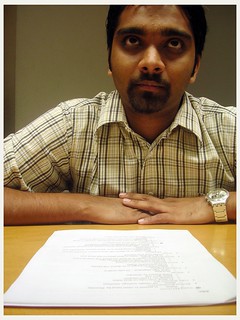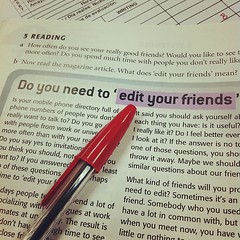I know, it’s easier said than done, but truly, one of the best things you can do to improve your writing is to create or join a critique group. Having a network of writing friends helps to keep you sane, but more than that, a good critique group gives you hands-on help that no writing conference or craft book can touch.
Finding critique partners
This is truly the hard part. There are often critique partner matches going on ad hoc in the comments of popular blog posts, but you can also look to the forums of sites like Absolute Write and (I believe) CPseek.
Writers conferences can be another great place to meet potential critique partners. My critique group formed at a (kinda awkward) writers’ meeting. Another plus: we live close enough to meet in-person!
Finding GOOD critique partners
Just finding other writers isn’t the tricky part. You critique partners don’t have to write in the same genre, but you should at least be familiar with the conventions of one another’s genres. More than that, however, effective critique partners understand the mechanics of storytelling, characterization, and good writing. It can be very difficult to balance widely divergent skill levels, but this can be a personal preference.
For an effective critique group, you’ll probably need three to seven or so members. More than that and it gets unwieldy; less, and you’re only getting one additional set of eyes. Also important—although this can take a little time—you have to be able to talk freely and trust one another’s feedback. Critique partners should also know how to give useful, helpful feedback without tearing you down. Even the best advice in the world isn’t helpful if it cripples your ability to write.
Scheduling
 For a longstanding critique group, as Josi S. Kilpack says, a set meeting schedule really helps to keep your group from petering out, especially if your group is online only. My critique group usually meets in-person twice a month, but during busy times we’ve met via Skype or just sent feedback in Word docs.
For a longstanding critique group, as Josi S. Kilpack says, a set meeting schedule really helps to keep your group from petering out, especially if your group is online only. My critique group usually meets in-person twice a month, but during busy times we’ve met via Skype or just sent feedback in Word docs.
Format
Typically, a critique group has each member submit one chapter per meeting, then all chapters are read and discussed in a roundtable manner. But that’s not the only workable format for a critique group.
In my critique group, for example, we have one person submit their entire novel, a quarter at a time. We typically look at higher level problems of plot, pacing, character arc and characterization. It’s hard to dig too deep into word-level issues, but more than that, when we read the novel this quickly and in these large chunks, we’re able to see these high-level gaps more easily than if we’d read the first chapter six months ago, with six others’ chapters.
When is my book ready for a critique group?
This may also depend on how your critique group works. Some people use critique groups for a final polish, others bring rough ideas or outlines to work on the basic direction of the story.
I use my critique group as my first or second round of readers. If they’re my second round, my first round gets my book as soon as I’ve smoothed out the gaps I left in the first draft, just to see if the story works overall. Then my critique group breaks it down by quarters, focusing more on the storytelling particulars.
Another plus of this: because some of the changes we have to make are large, no one has wasted too much time nitpicking text that might change or be cut altogether.
After I go back through and make the changes from critique notes and work on the copy editing, if I’ve made big changes, my group will (kindly) take another look, either before or after a round of beta readers. Then it goes off to my editor!
What do you think? How does your critique group work? How did you find your critique partners?
Photo credits: Poet and photographe, version toile—Julie Kertesz; At the office—C/N N/G




